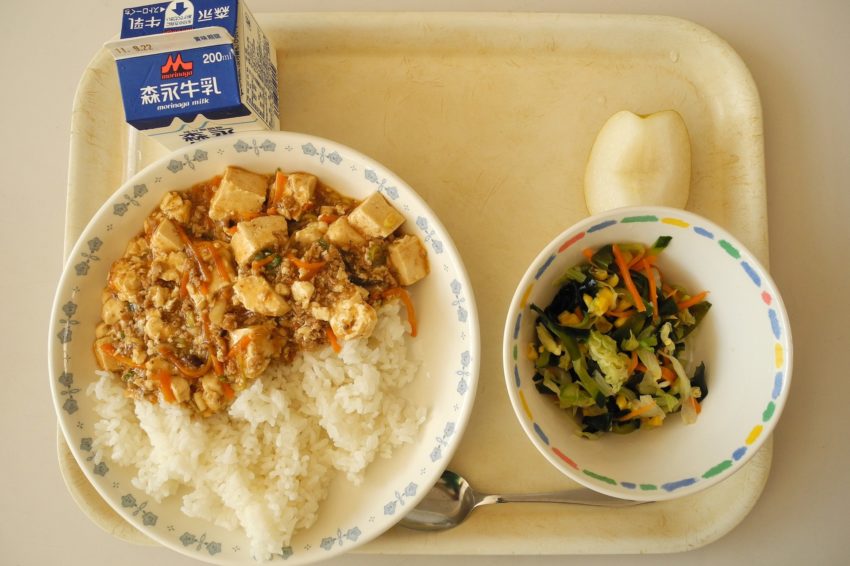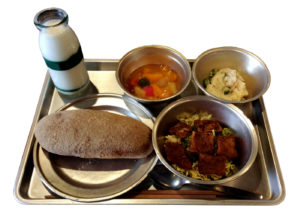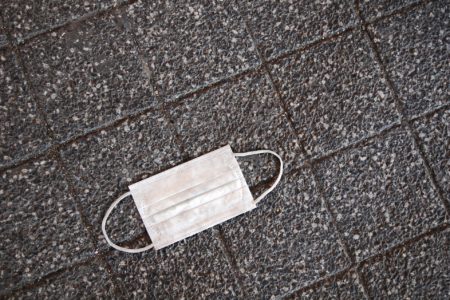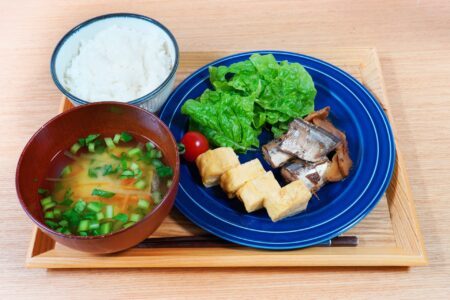Kyushoku: Japan’s Stellar School Lunches

Do you remember school lunch as a kid? Did you jump for joy when it was time to receive your rectangular slice of pizza? Did you loathe tuna salad day? Well reminisce no longer, for if you decide to become an Assistant Language Teacher at a public school in Japan, you shall be inducted into the glorious world of kyushoku (給食), or Japanese school lunch.

Metal dishes, glass milk bottles and bread are often associated with Showa-era school lunches. Photo Credit: Project Kei (CC BY-SA 4.0) Wikimedia Commons Link
School lunches are common around the world, but Japan’s system is without a doubt one-of-a-kind. The nationwide school lunch program began in the 1950’s and has remained a fixture of nearly all elementary and most junior high schools ever since. Over the decades school lunches have evolved and diversified, although many of the principles have remained the same. Here’s a brief introduction to the joys of school lunch in Japan!
A Balanced & Varied Menu
Usually, a typical kyushoku is made up of a starch dish (commonly rice, bread or noodles), a soup (such as miso or minestrone), a vegetable dish, a meat dish, and milk to drink. There are many variations on this template, with dishes sometimes combined (for example, with pork curry or meat sauce spaghetti). Desserts also pop up from time to time, though tend to lean towards healthier fare like fresh fruit or yogurt. Even the milk may occasionally be changed up with chocolate or strawberry-flavoring powder.
The goal of school lunches is multifold; not only do they provide children with a balanced, healthy meal, but they promote acceptance of variety. Students are encouraged to try new foods, as Japanese staples are often mixed with those of other countries, and of course “cleaning your plate” is expected. The absence of choice- students at most schools are required to have the school lunch throughout their elementary years- actually works to promote less picky eating habits.
It also provides a balancer for children from different economic backgrounds, as everyone eats the same food. Enough is made each morning to ensure that everyone gets at least one portion of every dish. In the case of junior high schools, where students are growing more rapidly, usually enough is prepared for seconds for those who want or need them.
Made Fresh, Healthy and & Cost-Efficient
Speaking of preparation, school lunches are made daily, either at a school lunch center or the schools themselves if they’re equipped with the facilities. Many of the ingredients are fresh and come from local farmers through agreements with the city.
The nutrition of young students is taken very seriously in Japan, and the lunches that are prepared reflect that. Lunch plans and composition are designed ahead of time by the school nutritionist, and each portion is constructed with a certain amount of caloric intake in mind, ensuring that the school lunch you eat every day is part of a perfectly balanced diet. The average lunch costs roughly 250 yen, or $2.33, an unbelievable bargain for a delicious, well-balanced meal.
An Important Part of School Life
Kyushoku is not only delicious, but it is an important part of the day for students socially as well. Every day, lunchtime roles are designated; students may go downstairs to pick up the classes’ portions in containers or on carts.
They then serve the lunch to the rest of the class- if you’re ever invited to attend lunch at a school, be prepared to be patient as eating doesn’t begin until everyone has been served.
Some smaller schools do have a communal lunch area where the Sts will go to eat outside of their class rooms, but the responsibilities remain. Lunch is typically the main time of the day (besides short breaks between classes and recess) where students are able to converse freely.
Depending upon the school, even the teachers will sit with the students in their assigned lunch groups or in the cafeteria (depending on size of school and which system they wish to use) and converse with them. These conversations over meals about non-school related topics help to deepen bonds between students and teachers. The current climate of social distancing has hampered this somewhat (it’s more common for teachers, including ALTs, to eat in the staff room) this tradition will no doubt return once it becomes safer to do so.
In Conclusion
Lest you get the wrong idea, you don’t have to participate in school lunch. While it is expected of the students and staff to partake in it, concessions have to be made for those with dietary restrictions. This includes teachers. For ALTs who prefer a vegetarian, vegan or other type of diet, the school lunches may not always be tailored to your tastes (you can always opt out of one or two items if you have particular allergies or religious reasons).
However, if you don’t have issues with any foods, then it’s highly recommended that you participate in receiving school lunch. Not only because of the many positive attributes I’ve described above, but also because the entire school body joining in eating the school lunch that was prepared for them that day is culturally important and an experience worth partaking in. Fresh, delicious, nutritious, inexpensive meals. What more could one ask for? Kyushoku is most certainly high up on the list of perks for being an ALT in Japan. I highly recommend trying it!
For more information on how you can enjoy school lunches & much more in Japan, read about the job of an ALT and how you can experience Japan!
Photo Credits:
1 – Project Kei licensed under the Creative Commons Attribution-Share Alike 4.0 International license. Wikimedia Commons Link
All other content (text) created by the original author and © 2020 MUSUBI by Borderlink
RELATED
-

Get Taught in Tokyo (and Beyond)
Top Photo: Louie Martinez on Unsplash If you are coming to Japan to be a teacher, prepare to be a student alon… -

Corona Fear: How Japan is Coping
Top Image: danielbichler on Pixabay 2020 will be defined by any number of things, but no doubt the COVID-19 pa… -

My Ten Yen on Healthy Eating in Japan
Top photo: ojisan200 on PhotoAC Eating healthy in Japan can make you feel good and bring you joy. Japanese foo…
PEOPLE

Connor Steck
From the US
Started his new life in Japan with a year in Hokkaido!




